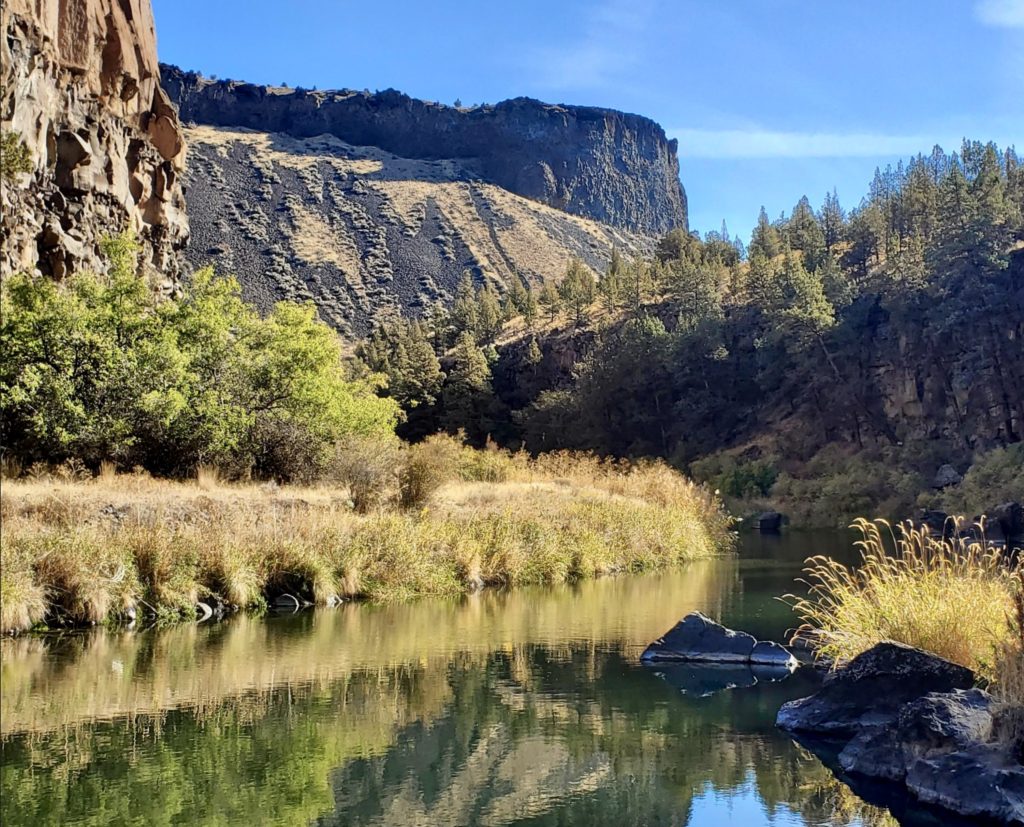Oct. 2, 2023
By Kimberley Priestley and WaterWatch of Oregon Staff
After a decade of advocacy to restore and protect the flows of the Crooked River in Central Oregon, long-awaited legal protection for flows released from Prineville Reservoir for downstream fish and wildlife has at last been approved.
The Crooked River in Central Oregon is one of Oregon’s crown jewels. Winding through farmlands, Smith Rock State Park, and miles of wilderness canyons, the river provides a mixture of intact and compromised habitat for fish and wildlife, including prized redband trout and imperiled steelhead. And as with most rivers in Oregon, the Crooked brings considerable economic vitality to the region.
Since completion of the Bowman Dam in 1961, most of the Crooked River’s flow above the Opal Springs area has been controlled by releases from the federally-owned Bowman Dam, upstream of Prineville. That dam was originally built to supply irrigation water and to control floods, with only minimal amounts of water allotted to protect streamflows needed for fish.
But while roughly half of the 155,000 acre-feet of water stored behind the dam was claimed by irrigation, the remaining water was untapped — a rare happenstance in the West. For decades fish and river advocates fought for a legal claim to this unallocated water, but it wasn’t until the passage of the Crooked River Collaborative Water Security and Jobs Act of 2014 — which WaterWatch helped negotiate, draft and secure — that fish gained formal access to nearly 80,000 acre-feet of water.
A key provision of the Act that WaterWatch helped secure directs the Bureau of Reclamation to store, release and use water for downstream fish and wildlife “in accordance with Oregon state water law.” Requiring the volume of water designated for downstream fish and wildlife to adhere to state law meant the Bureau had to ensure water intended for fish was legally protectable instream against other water right users.
Gaining instream protection was a two-step process. The Bureau needed to transfer half of its irrigation storage water right to allow storage for downstream fish and wildlife, but it also needed to procure a secondary water right to protect the water released from storage for fish instream from the reservoir to Lake Billy Chinook 72 miles downstream.
In 2018, after a year of negotiations and a legal challenge, WaterWatch helped negotiate the Bureau’s new water storage right for the previously unallocated stored water behind Bowman Dam that will provide, in a normal water year, for 68,000 acre-feet of the 155,000 acre-feet of water stored for downstream fish, and an additional 10,000 acre-feet that can be used by irrigation or fish and wildlife.
But while the storage right was resolved, the Bureau was slow to apply to the state for a secondary water right to protect released water instream against use by downstream irrigators in the reach between Bowman Dam and Lake Billy Chinook.
After pressures brought by the 2020 Deschutes Basin Habitat Conservation Plan’s direction to the Bureau to pursue a secondary water right for fish, as well as legal inquiries by Advocates for the West on behalf of WaterWatch, the Bureau finally applied for a water right in June 2021. In September 2023, the Oregon Water Resources Department issued the final order and secondary water right permit that will protect flows in the Crooked into the future — a huge legal victory for the river!
From now on, all water released from Prineville Reservoir for fish will be protected in the river throughout the 72-mile stretch from the reservoir to Lake Billy Chinook.
And in addition to the critical milestone of obtaining legal protection for instream flows in the Crooked River, WaterWatch’s longstanding work to block new storage projects above Prineville Reservoir — including one large project that would have inundated a section of the Wild and Scenic North Fork Crooked — resulted in those applications being pulled. With the proposed storage projects now no longer a threat, the water at issue under these applications can flow into Prineville Reservoir to meet the downstream fish flows protected by the Crooked River Act and the newly-minted state water right, adding to this hard-won victory.
This article originally appeared in the fall 2023 issue of WaterWatch of Oregon’s Instream newsletter. Crooked River photo by Gavin Hoban.

